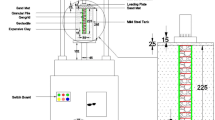Abstract
Expansive soils undergo alternate swelling and shrinkage respectively in rainy seasons when they absorb water and in summers when water evaporates from them. Hence, all types of foundations constructed in expansive soils are also subjected to alternate swelling and shrinkage in rainy and summer seasons. As a result, super-structure members are also affected, undergoing severe distress. Various tension-resistant and innovative foundation techniques such as belled piers and under-reamed piles have been devised for arresting the problems posed by expansive soils. Granular pile-anchor (GPA) is a recent innovative technique suggested for expansive clay beds. GPA is quite effective in controlling heave or swelling. Useful experimental heave data were obtained on laboratory scale and field scale GPAs. However, it is also necessary to study the behaviour of GPA-reinforced expansive clay beds subjected to swelling and shrinkage. This paper presents experimental data on shrinkage of GPA-reinforced expansive clay beds. Laboratory scale GPA-reinforced expansive clay beds were subjected to alternate swell–shrink cycles, each cycle for a duration of 300 days. Each clay bed was subjected to three swell–shrink cycles (N = 1, 2 and 3), each cycle monitoring swelling for 10 days and shrinkage for 90 days. The number of GPAs (n) reinforcing the clay beds was varied as 0, 1, 2 and 3. Shrinkage (mm) of a clay bed, recorded in a given swell–shrink cycle, decreased with increasing number of GPAs (n). Further, shrinkage of a given clay bed decreased significantly with increasing number of swell–shrink cycles (N) also. It was also found that shrinkage (mm) of a particular layer in the clay bed decreased with increasing depth (z) of the layer from the top of the clay bed.











Similar content being viewed by others
References
Acosta H, Edil T, Benson C (2003) Soil stabilization and drying using fly ash. Geo Engineering Rep. no. 03-03, Dept. of Civil and Environmental Engineering, Univ. of Wisconsin-Madison, Madison
Chen FH (1988) Foundations on expansive soils, 2nd edn. Elsevier, Amsterdam
Hoyos LR, Puppala AJ, Chainuwat P (2004) Dynamic properties of chemically stabilized sulfate rich clay. J Geotech Geoenviron Eng 130(2):153–162
Hunter D (1998) Lime-induced heave in sulfate-bearing clay soils. J Geotech Eng 114(2):150–167
Lu N, Lykos W (2004) Unsaturated soil mechanics. Wiley, New York
Nelson DJ, Miller JD (1992) Expansive soils: problems and practice in foundation and pavement engineering. Wiley, New York
Petry MT, Little HD (1992) Update on sulfate-induced heave in treated clays: problematic sulphate levels. Transportation research record. 1362, Transportation Research Board, Washington, pp 51–55
Phanikumar BR (1997) A study of swelling characteristics of and granular pile anchor foundation system in expansive soils. Ph.D thesis. Jawaharlal Nehru Technological Univ., Hyderabad
Phanikumar BR (2009) Effect of lime and fly ash on swell consolidation and shear strength characteristics of expansive clays: a comparative study. Geomech Geoengin Int J 4(2):175–181
Phanikumar BR, Sharma RS (2004) Effect of fly ash on engineering properties of expansive soils. J Geotech Geoenviron Eng 130(7):764–767
Phanikumar BR, Sharma RS, Rao AS, Madhav MR (2004) Granular pile-anchor (GPAs) foundation system for improving the engineering behaviour of expansive clay beds. ASTM Geotech Test J 133(5):531–538
Phanikumar BR, Rao AS, Suresh K (2008) Field behavior of granular pile-anchors in expansive soils. Ground Improv 161(4):199–206
Phanikumar BR, Mani AJ, Sathiyasheelan S, Reddy PR (2009) Fly ash columns (FAC) as an innovative foundation technique for expansive clay beds. Geomech Geoengin Int J 4(3):183–188
Rao AS, Phanikumar BR, Dayakar Babu R, Suresh K (2007) Pullout behavior of granular pile-anchors (GPAs) in expansive clay beds in situ. J Geotech Geoenviron Eng 133(5):531–538
Rao AS, Phanikumar BR, Suresh K (2008) Response of granular pile-anchors (GPAs) under compression. Ground Improv 161(3):121–129
Rollings RS, Burkes JP, Rollings MP (1999) Sulphate attack on cement-stabilized sand. J Geotech Geoenviron Eng 125(5):364–372
Sharma D, Jain MP, Prakash C (1978) Handbook on under-reamed and bored compaction pile foundations. Central Building Research Institute, Roorkee
Walsh K, Houston WN, Houston SL (1993) Evaluation of in-place wetting using soil suction measurements. ASCE J Geotech Eng 119(5):862–873
Wheeler SJ, Sharma RS, Buisson MSK (2003) Coupling of hydraulic hysteresis and stress-strain behaviour in unsaturated soils. Geotechinque 53(1):41–54
Author information
Authors and Affiliations
Corresponding author
Rights and permissions
About this article
Cite this article
Muthukumar, M., Phanikumar, B.R. Shrinkage Behaviour of GPA-Reinforced Expansive Clay Beds Subjected to Swell–Shrink Cycles. Geotech Geol Eng 33, 475–485 (2015). https://doi.org/10.1007/s10706-014-9833-9
Received:
Accepted:
Published:
Issue Date:
DOI: https://doi.org/10.1007/s10706-014-9833-9




